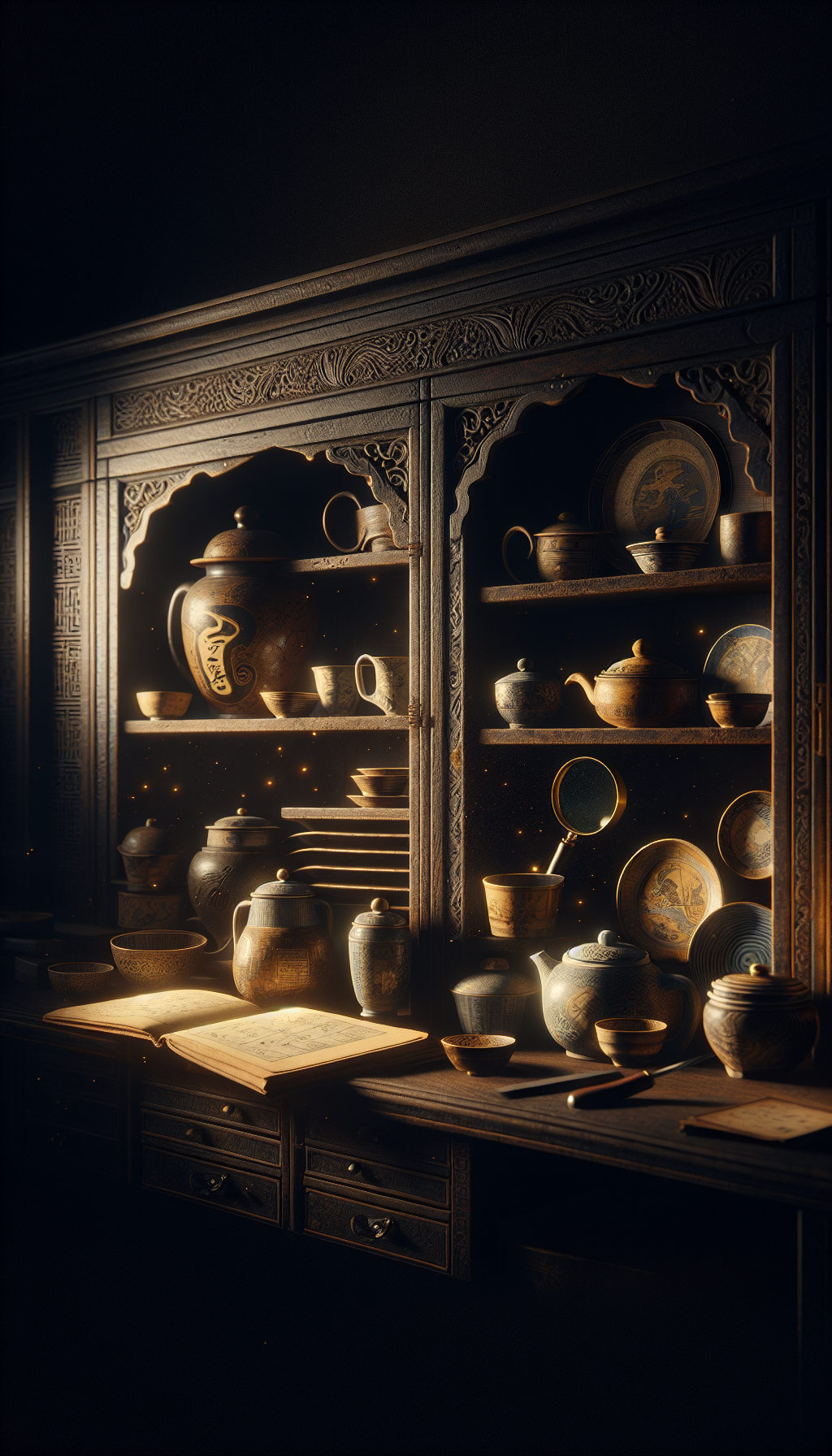A Famille Rose Dish With Peaches And Bats Yongzheng Mark
Antique Chinese porcelain rarely combines elegance and symbolism as succinctly as a famille rose dish scattered with peaches and flying bats. When such a dish also bears the six-character Yongzheng reign mark (1723–1735), the stakes rise for collectors and appraisers. The Yongzheng era is celebrated for refined forms, exacting potting, and sophisticated enameling, making mark-and-period dishes highly coveted and widely imitated.
This guide explains the motif’s meaning, how to read Yongzheng marks, what to look for in body, glaze, and enamels, how to differentiate Yongzheng from later examples, and which condition factors matter most.
Why the peaches-and-bats motif matters
- Peaches (tao): The fruit of longevity (shou), linked to the Daoist Queen Mother of the West. On porcelain, peaches often appear ripe, blushed, and leaf-rich, sometimes in clusters or as the famous “nine peaches” pattern.
- Bats (fu): A rebus for “good fortune,” as “bat” (蝠, fu) sounds like “blessing” (福, fu). Red bats add a second pun: hong fu (great fortune).
- Five bats: When five are depicted circling peaches, the group alludes to the Five Blessings—longevity, wealth, health, love of virtue, and a peaceful end.
Together, peaches and bats signal “abundant blessings and longevity,” a fitting gift for birthdays and courtly occasions. During Yongzheng, the imperial aesthetic favored restraint: a pale or white ground with carefully spaced motifs, subtle shading, and sophisticated negative space. Later, especially under Qianlong, designs often became busier and brighter, but the auspicious combination remained a perennial favorite.
Understanding Yongzheng marks
Most Yongzheng-period imperial porcelains bear a six-character reign mark “大清雍正年製” (Da Qing Yongzheng Nian Zhi), typically in underglaze blue. Key points:
- Script and layout: Small, neat regular script (kaishu) arranged in two vertical lines of three characters within double blue circles on the base is common. Strokes are even, well-spaced, and disciplined; the characters neither crowd nor float.
- Cobalt tone: Yongzheng cobalt tends to be clear and even, without the darker “heaped and piled” spotty pooling associated with Kangxi. The blue reads as clean, slightly soft, and controlled in line quality.
- Alternatives: Some famille rose wares may show enamelled iron-red marks, but they are less common for this type of dish. Incised reign marks are not typical for standard famille rose dishes.
- Scale and position: The mark is modest in size, centered, and sharply painted. The double circles are consistent, their lines crisp and without trembling.
Caution: Apocryphal Yongzheng marks were plentiful in the 19th and 20th centuries. A correct mark is a necessary but never sufficient condition for a Yongzheng attribution; body, glaze, enamels, and potting must align.
Materials and making: What the best pieces show
A Yongzheng mark-and-period famille rose dish usually reflects imperial standards from Jingdezhen.
Potting and form:
- Body: Very fine, high-fired porcelain with thin, even walls. The dish feels light for its size, yet robust.
- Profile: A well-proportioned shallow dish or saucer dish with a gentle flare to the rim. Diameters vary; small dishes around 15–18 cm are frequent, with medium sizes around 22–26 cm also encountered.
- Footrim: Neatly cut foot with a smooth, slightly beveled inner edge. The unglazed foot shows tight, fine-grained paste. There is often a subtle, warm iron tint (“apricot skin”) from kiln firing, but not a coarse, sandy ring.
Glaze:
- Surface: Lustrous, smooth, and “silky” to the touch with a faint bluish tinge in pooled areas. The glaze pulls up cleanly on the footrim with no thick drips.
- Base: Clean and well-finished. Minor and shallow wheel chatter marks may be visible, but spur marks are uncommon on top-quality imperial dishes of this period.
Enamels (famille rose / fencai):
- Palette: Early 18th-century rose enamels often appear translucent and softly shaded. Pink is built up in fine washes rather than a single opaque block. Whites, pale yellows, soft greens, and turquoise are integrated to model fruit and leaves.
- Modeling: Peaches are shaded from pale yellow near the stem into pink and deeper carmine at the blush, with soft transitions. Leaves display blue-green tonalities with careful veining in darker green or blackish enamel. Bats are typically painted in coral or iron-red, sometimes with very fine outline strokes and touches of shading, appearing airborne rather than blocky.
- Line quality: The drawing is confident and refined, with small, deliberate brushstrokes. Outlines are not heavy and lack the graininess seen in later, cheaper enamels.
Ground and spacing:
- The best Yongzheng pieces leave generous white ground, allowing motifs to “breathe.” Spacing feels intentional, with bats swirling around fruit, not colliding or crowding the rim.
Dating and attribution: Yongzheng vs later
Distinguishing a true Yongzheng dish from later examples (Qianlong, 19th century, Republic, or modern) requires reading the whole object:
Versus Qianlong (1736–1795):
- Drawing: Qianlong famille rose tends to be more elaborate, with denser compositions and occasionally heavier outlines. Nine-peach compositions became especially popular, often with more fruit than empty ground.
- Enamels: Colors can be brighter and opaquer. Pinks may appear more saturated and do not always display the same fine, feathered shading associated with Yongzheng’s courtly refinement.
- Body and foot: Still imperial quality in the best pieces, but potting can be slightly heavier; footrims are precise but sometimes broader.
Versus 19th-century (Jiaqing–Guangxu) and Republic period:
- Mark: Apocryphal Yongzheng marks are common, often larger, more mechanical, or carelessly painted. Double circles may wobble or be too thick. Blue might seem harsh or dull.
- Body and glaze: Later bodies often feel heavier. Glazes can be glassier and colder white, lacking the subtle bluish pooling. Footrims may be more chalky or display coarser grain; some later examples show a uniform, manufactured appearance to the unglazed ring.
- Enamels: Later reds and pinks can look brighter or more orange; green enamels sometimes appear thicker and more powdery, with tiny surface bubbles. Shading is less nuanced; bats may look stiff with formulaic outlines.
- Drawing: Composition may be crowded or naïve. Motifs repeat with less variation, and leaves can look flat, with simplified veining.
Versus modern reproductions:
- Transfer evidence: Uniform, printed outlines or stipple patterns under enamel. Repetitive identical brush marks signal non-hand-painted elements.
- Artificial aging: Dirt trapped uniformly on the footrim, deliberate scoring, or tea-stained bases. UV reveals heavy, modern retouching on enamels or rim.
- Sound and feel: The potting can feel “dead” compared with the lively resonance of high-fired Qing porcelain. Glaze may appear overly bright, and the footrim perfectly white or uniformly dyed.
Special cases:
- Falangcai (imperially enamellled in the palace studios) exist in the period but are exceptionally rare and differ in palette and technique. Most peaches-and-bats dishes encountered in the market are Jingdezhen-made fencai (famille rose), sometimes termed yangcai for imperial commissions.
The safest approach is holistic: assess mark, potting, glaze, enamel technique, composition, and wear together. If any of these contradict the purported period, proceed cautiously.
Condition and value factors
Even superb Yongzheng examples have lived long lives. For appraisal, note:
Enamel condition:
- Look for micro-chips (fritting), flaking on high-relief strokes, or abrasion from stacking. Early famille rose is vulnerable to wear, especially pinks and iron-reds.
- Overpainting: Modern restoration may introduce a glossy, slightly raised enamel. UV light often reveals overpaint as a different fluorescence.
Structural integrity:
- Rim frits and small glaze nicks are common; hairlines radiating from the rim are more serious.
- Star cracks to the base, body cracks, and repairs reduce value materially.
- A drilled foot (for lamp conversion) is a significant detractor.
Footrim and base:
- Check for grind marks from polishing out chips, recoloring of the foot to simulate age, or filled losses.
- Honest wear shows as smooth, gentle abrasion consistent with use, not sharp scratches or uniform staining.
Gilding (if present):
- Some dishes have gilded details on rims or bats. Period gilding wears softly and irregularly; fresh, brassy gilding suggests later enhancement.
Provenance:
- Old collection labels, auction stencils, and documented ownership help support period attributions and improve market confidence.
Market:
- Mark-and-period Yongzheng famille rose dishes with peaches and bats can achieve significant prices at auction, particularly with imperial quality, strong condition, and good provenance.
- Apocryphal mark 19th-century examples remain collectible but at a fraction of the value.
- Condition issues can swing prices widely; a short, clean hairline might reduce value modestly, while extensive restoration or a drilled base is far more impactful.
Practical appraisal checklist
- Confirm the reign mark:
- Six-character “大清雍正年製” in neat underglaze blue, small and centered within double rings; disciplined calligraphy and even cobalt.
- Read the body and glaze:
- Thin, refined potting; silky glaze with slight bluish pooling; clean base; neatly cut footrim with fine-grained paste and subtle iron tint.
- Evaluate enamels:
- Softly shaded pinks and greens; confident brushwork; bats in coral-red with life and motion; controlled outlines without grainy pooling.
- Judge composition:
- Balanced spacing, ample ground, natural flow of bats around peaches; Yongzheng restraint rather than crowding.
- Compare period traits:
- Contrast with Qianlong’s busier style and brighter opaques; beware 19th–20th-century apocryphal marks and powdery enamels.
- Inspect condition:
- Use magnification and UV to locate overpaint; check for hairlines, star cracks, rim frits, footrim alterations, and drill holes.
- Consider provenance:
- Record labels, old photos, auction references, and receipts; they support attribution and value.
- When in doubt:
- Seek a specialist opinion. A few millimeters in potting or a nuance in script can decide period.
FAQ
Q: How can I tell a Yongzheng mark-and-period dish from a later piece with an apocryphal Yongzheng mark? A: No single feature decides it. Look for imperial-level potting, a silky glaze with subtle pooling, refined famille rose shading, and a small, disciplined underglaze-blue mark in double circles. Later pieces often have heavier bodies, brighter, more opaque enamels, powdery green tones, and a larger or clumsier mark. Evaluate all features together.
Q: Are Yongzheng marks ever written in iron-red enamel on famille rose dishes? A: They exist, but for peaches-and-bats dishes the standard is a six-character underglaze-blue mark. Red-enamel marks appear more frequently later in the 18th and 19th centuries and on other wares. Treat iron-red-mark examples cautiously and scrutinize the rest of the vessel.
Q: Does a “nine peaches” pattern automatically mean Qianlong, not Yongzheng? A: The nine-peaches composition is strongly associated with Qianlong, where it became especially popular, but motif counts alone don’t determine period. Examine potting, palette, and mark. Yongzheng pieces typically exhibit more restraint and softer shading.
Q: Is light stacking wear to enamels a deal breaker? A: Not necessarily. Honest, modest abrasion to high points is expected. Large areas of enamel loss, crude overpainting, or color mismatch under UV are more concerning and affect value.
Q: Should I clean or polish the footrim or enamels? A: Avoid aggressive cleaning. Do not sand or bleach the footrim to “freshen” it, and avoid solvents on enamels. Dust with a soft brush and consult a conservator for any soiling or repairs. Over-cleaning can erase age indicators and reduce value.
By combining an understanding of Yongzheng-era aesthetics with close observation of body, glaze, enamels, and the reign mark, you can form a confident appraisal of a famille rose dish with peaches and bats. When evidence aligns—potting finesse, silky glaze, subtle shading, and a disciplined mark—the result is one of Qing porcelain’s most rewarding acquisitions.




